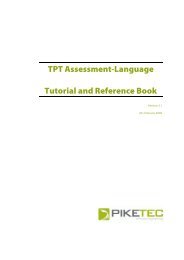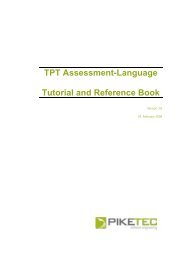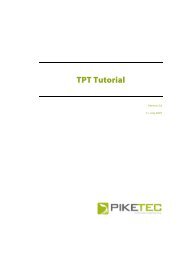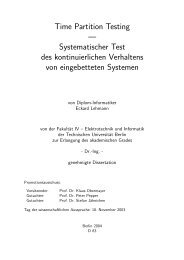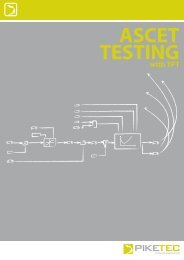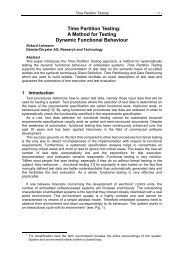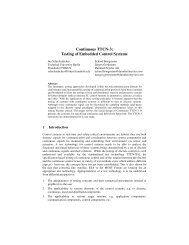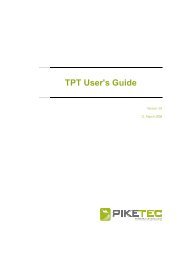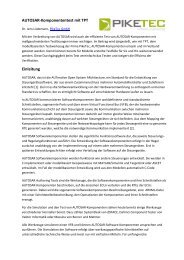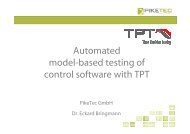TPT User's Guide - PikeTec
TPT User's Guide - PikeTec
TPT User's Guide - PikeTec
Create successful ePaper yourself
Turn your PDF publications into a flip-book with our unique Google optimized e-Paper software.
Page 84 <strong>TPT</strong> User’s <strong>Guide</strong><br />
15.8.1 First column – Object overview<br />
The first column contains a tree, which shows the hierarchy of all the testlets, transitions and<br />
paths in this order. Each object has the two nodes “variants”, which lists all the variants of an<br />
object, and “pairs”, which contains a list of all other testlets, transitions and paths.<br />
A completely opened testlet-node can be seen in Figure 60, number 1.<br />
15.8.2 Second column - Amount<br />
The second column simply displays the amount how often a testlet and its states were used in<br />
all scenarios. The percentage can be read of the size of the bar, which relates to the total<br />
number of scenarios (see Figure 60, number 2).<br />
15.8.3 Third column – Spreading of variants<br />
To see whether tests are distributed well <strong>TPT</strong> analyses the coverage of all states in a single<br />
testlet. Therefore <strong>TPT</strong> calculates the “distance” between the current spreading and the optimal<br />
possible arrangement with the amount of the testlet.<br />
The example (see Figure 60 number 2/3) shows that the testlet ”changing light intensity” is<br />
used six times. In detail: one state is used four times; the second two times and the three<br />
remaining are never used. The optimal arrangement with five states and six available would be<br />
one state two times and every other state once.<br />
Similar to the process of standard deviation <strong>TPT</strong> calculates in this case a value of 2.8. The<br />
appropriated green bar relates to the worst calculated value of all objects.<br />
15.8.4 Fourth column – Spreading of combinations<br />
To evaluate the coverage it is also important to consider the combinations of two objects. To<br />
realize the importance an example: two testlets can be good in the sense of the second column<br />
but state 1 of testlet A is only used with state 2 of testlet B. To cover such problems <strong>TPT</strong> also<br />
calculate a value for the combinations of objects.<br />
The relation between two objects and its variants can be described by a matrix which contains<br />
the amounts of a state in combination with every other variant. Similar to the spreading of<br />
variants <strong>TPT</strong> calculates the “distance” between this matrix and the best possible distributed<br />
matrix with the same total amount. This value is now called the distance between two objects<br />
(see Figure 60, number 5).<br />
Out of all the distances the average distance of a testlet is made and shown in the fourth<br />
column (see Figure 60, number 4). The bar again is related to the biggest distance between two<br />
objects. In addition the blue line over the bar shows the minimum and maximum distance from<br />
this testlet.<br />
15.9 Restore from history<br />
<strong>TPT</strong> automatically saves a copy of the currently open file at regular intervals if it has been<br />
changed. A backup is created every five minutes by default or when the user saves the file<br />
manually. By default a total of twenty backups are kept and may be restored.<br />
To restore a backup, use the menu item File | Restore From History. There, you will<br />
find an overview, listing all saved backup files along with their backup time and information<br />
about whether the save operation has been performed manually or automatically. To restore a<br />
backup file, select the desired backup time in the list and use the “Restore” button.



